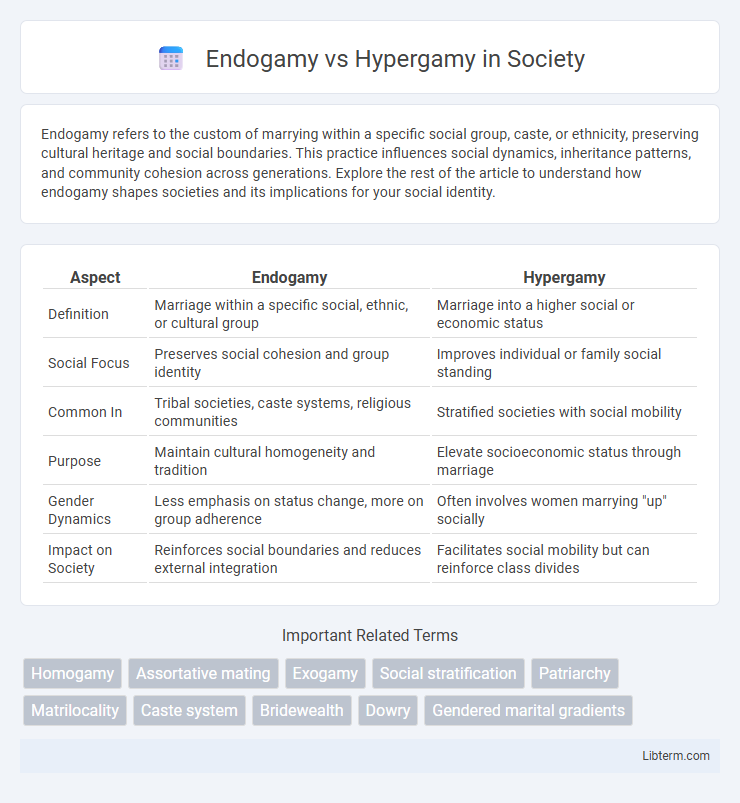Endogamy refers to the custom of marrying within a specific social group, caste, or ethnicity, preserving cultural heritage and social boundaries. This practice influences social dynamics, inheritance patterns, and community cohesion across generations. Explore the rest of the article to understand how endogamy shapes societies and its implications for your social identity.
Table of Comparison
| Aspect | Endogamy | Hypergamy |
|---|---|---|
| Definition | Marriage within a specific social, ethnic, or cultural group | Marriage into a higher social or economic status |
| Social Focus | Preserves social cohesion and group identity | Improves individual or family social standing |
| Common In | Tribal societies, caste systems, religious communities | Stratified societies with social mobility |
| Purpose | Maintain cultural homogeneity and tradition | Elevate socioeconomic status through marriage |
| Gender Dynamics | Less emphasis on status change, more on group adherence | Often involves women marrying "up" socially |
| Impact on Society | Reinforces social boundaries and reduces external integration | Facilitates social mobility but can reinforce class divides |
Understanding Endogamy: Definition and Cultural Roots
Endogamy refers to the social practice of marrying within a specific cultural, ethnic, or social group, preserving communal identity and traditions. Rooted in cultural and religious norms, endogamy reinforces social cohesion by maintaining shared values, beliefs, and heritage across generations. This practice is prevalent in various societies worldwide, shaping social structures and influencing group solidarity.
Hypergamy Explained: Social and Biological Perspectives
Hypergamy refers to the practice of marrying or forming a relationship with a partner of higher social status, wealth, or caste, often driven by social mobility and economic benefits. From a biological perspective, hypergamy can be linked to evolutionary strategies where individuals seek mates with traits that signal better resources or genetic fitness, enhancing offspring survival. Socially, hypergamy influences marriage patterns by reinforcing class stratification and impacting gender dynamics within societies.
Historical Context: How Endogamy and Hypergamy Shaped Societies
Endogamy, the practice of marrying within a specific social group or community, historically reinforced social cohesion and preserved cultural, religious, and economic boundaries in societies worldwide. Hypergamy, the custom of marrying "up" into a higher socioeconomic or social status, often shaped social hierarchies by enabling upward mobility while maintaining elite dominance in caste systems, aristocracies, and class-based societies. Both endogamy and hypergamy influenced patterns of inheritance, power distribution, and social stratification, deeply impacting societal structures from ancient civilizations to modern times.
Motivations Behind Endogamous Marriages
Endogamous marriages are motivated by the desire to preserve cultural heritage, maintain social status, and strengthen family alliances within a specific community or group. These unions often ensure the continuity of traditions, language, and religious practices, reinforcing group identity across generations. Economic stability and shared values within a close-knit social network also play crucial roles in the preference for endogamy.
The Dynamics of Hypergamous Relationships
Hypergamous relationships often involve partners seeking a spouse with higher socioeconomic status, education, or social standing, which drives patterns of upward social mobility within communities. This dynamic contrasts with endogamy, where individuals marry within a specific social group or caste to maintain cultural or social continuity. The pursuit of hypergamy influences gender roles and marital expectations, frequently impacting family structures and inheritance practices across societies.
Endogamy vs Hypergamy: Key Differences and Overlaps
Endogamy refers to the practice of marrying within a specific social, ethnic, or cultural group, preserving group identity and traditions, while hypergamy involves marrying into a higher social or economic status, often described as "marrying up." The key differences lie in the primary motivation: endogamy emphasizes maintaining social boundaries, whereas hypergamy emphasizes social mobility and status enhancement. Overlaps occur when individuals marry within their group but choose partners of higher status, blending social reinforcement with upward mobility dynamics.
Social Implications of Endogamy and Hypergamy
Endogamy, the practice of marrying within a specific social group, reinforces cultural cohesion and strengthens community identity but can perpetuate social stratification and limit genetic diversity. Hypergamy, or marrying into a higher social status, often drives social mobility and alters power dynamics but may reinforce class disparities and gender roles. Both practices profoundly impact social structures by shaping marriage patterns, inheritance rights, and access to resources within societies.
Modern Trends: Are Patterns Changing in the 21st Century?
Modern trends reveal a shift in endogamy and hypergamy patterns, influenced by globalization, urbanization, and digital connectivity that broaden social networks beyond traditional boundaries. Increasing educational attainment and financial independence among women challenge traditional hypergamous dynamics, promoting more egalitarian partner selection. Online dating platforms and evolving social norms contribute to more diverse marital choices, reducing strict adherence to endogamous and hypergamous practices in many societies.
Psychological Effects of Endogamy and Hypergamy
Endogamy, the practice of marrying within a specific social group, often fosters a strong sense of identity and social cohesion but can limit psychological growth due to reduced exposure to diverse perspectives. Hypergamy, marrying into a higher social or economic status, may enhance self-esteem and social mobility but can also generate stress and identity conflicts due to perceived social pressures and expectations. Both practices influence psychological well-being through their impact on social networks, cultural belonging, and individual self-concept.
Endogamy, Hypergamy, and the Future of Relationships
Endogamy, the practice of marrying within a specific social, cultural, or ethnic group, contrasts sharply with hypergamy, where individuals marry into a higher social or economic class. As modern relationships evolve, digital platforms and shifting societal norms increasingly challenge traditional endogamous patterns, pushing the boundaries of hypergamous aspirations. Future trends in relationships may reflect a blend of both practices, influenced by global connectivity and changing values around social mobility and cultural identity.
Endogamy Infographic

 libterm.com
libterm.com